-
CENTRES
Progammes & Centres
Location
Against the backdrop of the pandemic, the budget continues to club the health sector with the social determinants of health
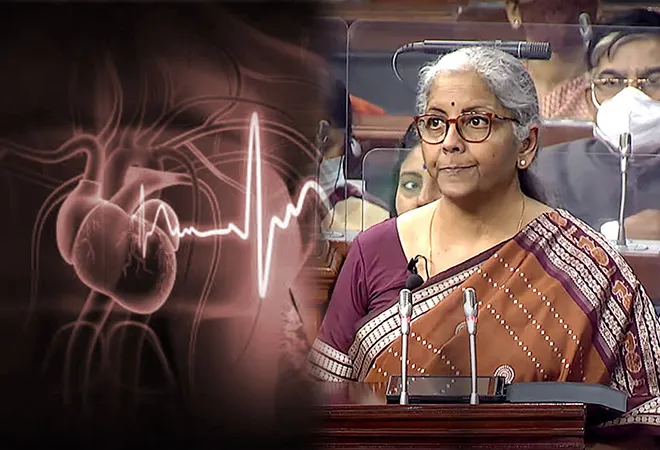
This brief is a part of the Budget 2022: Numbers and Beyond series.
For anyone listening to the Budget speech, Minister of Finance, Nirmala Sitharaman’s unequivocal statement that ‘capital investment holds the key to speedy and sustained economic revival and consolidation through its multiplier effect’—and, consequently, the outlay for capital expenditure in the Union Budget will be enhanced by 35.4 percent from INR 5.54 lakh crore last year to INR 7.50 lakh crore next year—held great promise for the health sector. After all, uncertainties in the last two years and the constant fear of the health infrastructure—starved by historical neglect—being overrun by the virus had taught India that a functioning health system is a core component of human security, including economic security.
However, the release of the detailed budget numbers have proven that any such hope of substantially high capital investments in the health sector was misplaced. Although India is admirably continuing the focus on the social determinants of health like housing, electricity, cooking gas, sanitation, roads and access to water with considerable, progressively increasing investments, this budget has not done anything substantial on augmenting capacity in the health sector in a way the situation demands.
Uncertainties in the last two years and the constant fear of the health infrastructure—starved by historical neglect—being overrun by the virus had taught India that a functioning health system is a core component of human security, including economic security.
This is despite some efforts like the Pradhan Mantri Atma Nirbhar Swasth Bharat Yojana (PM-ASBY), which has now been renamed the Pradhan Mantri–Ayushman Bharat Health Infrastructure Mission (PM-ABHIM) Scheme. The scheme was launched last year, with an outlay of about INR 64,180 crores over six years, aiming to develop capacities of primary, secondary, and tertiary care institutions, strengthen existing national institutions, and create new institutions to cater to the detection and cure of new and emerging diseases. In addition, Pardhan Mantri Swasthya Suraksha Yojana (PMSSY), a scheme spearheading the expansion of government infrastructure in medical education and healthcare delivery in the most hard-to-reach areas in the country, has seen enhanced allocation from INR 7,000 crore last year to INR 10,000 crore this year.
At the same time, these positive steps are overshadowed by the stagnation of resource flow to the National Health Mission (NHM), particularly in the middle of a pandemic, where the public healthcare delivery system has undoubtedly proven its worth, as private hospitals stepped back. As Graph 1 shows, NHM allocations are still even lower than the actual 2020 levels.
Graph 1: National Health Mission allocations across last three budgets
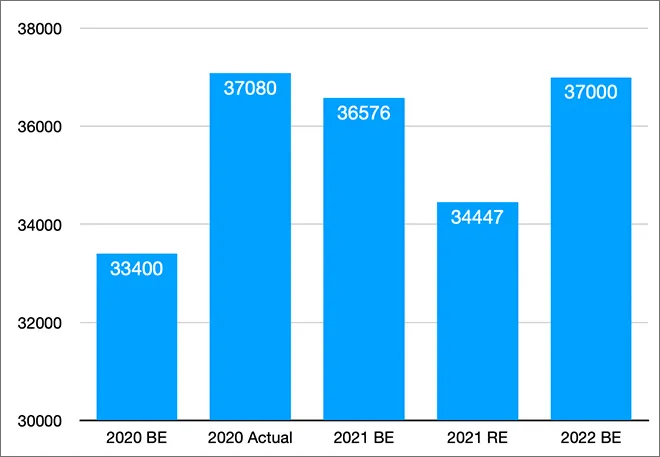 Source: https://www.indiabudget.gov.in/doc/eb/allsbe.pdf
Source: https://www.indiabudget.gov.in/doc/eb/allsbe.pdf
Even more concerning is the fact that, of the promised INR 750,245 crores of planned capital expenditure in the next year, the health sector gets a paltry INR 5,638 crores, or in other words, 0.75 percent. In comparison, road transport and highways get INR 187,744 crores or 25 percent; defence gets INR 160,419 crores or 21.4 percent; railways get INR 137,100 crores or 18.27 percent; communications get INR 55,039 or 7.34 percent; housing and urban affairs get INR 27,341 crores or 3.64 percent and space gets INR 7,465 crores or about 1 percent of the overall capital expenditure. While all these sectors are essential, the relatively low priority given to the health sector is remarkable in the pandemic context.
Overall, barring the Ayushman Bharat Digital Mission (ABDM), which aims to roll out an open platform consisting of digital registries of health providers and health facilities, a unique health identity, a consent framework, and universal access to health facilities; and the the National Tele Mental Health Programme (NTMHP), which will provide quality mental health counselling and care services, the core health sector has not gotten the attention it deserves in this budget, given that the pandemic had provided a historic opportunity to prioritise the health sector and channelise resources to augment infrastructure and human resources.
An earlier analysis of the status of implementation had shown that a high number of functional HWCs are concentrated in the relatively better off states, which makes more attention being given to the rollout an equity imperative.
The pace of new infrastructure creation in the health sector has certainly been affected by the disruption caused by the pandemic and, possibly, lack of funds. Ayushman Bharat–Health and Wellness Centres (AB-HWCs) are a case in point. According to the initial plans, 1.5 lakh new health and wellness centres (HWC) were to be created to provide comprehensive primary health care services by December 2022 (Graph 2 explains the rollout plan). However, data on the monitoring portal shows that as on 1st February 2022, only 76,633 HWCs have been operationalised across the country. This means that almost as many HWCs that were created over the last four years will have to be created during the remaining 11 months of 2022 to achieve the target. However, without focused attention and active resource support, this goal may not be achieved. An earlier analysis of the status of implementation had shown that a high number of functional HWCs are concentrated in the relatively better off states, which makes more attention being given to the rollout an equity imperative.
Graph 2: The Rollout Plan for the Ayushman Bharat Health and Wellness Centres
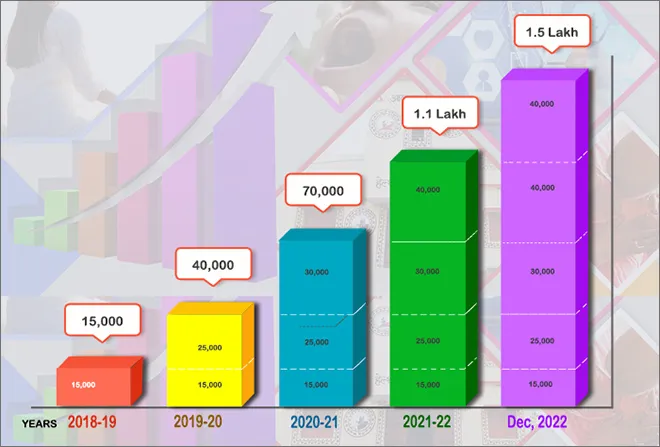 Source: https://ab-hwc.nhp.gov.in/
Source: https://ab-hwc.nhp.gov.in/
Last year’s budget document had tried to inflate the actual health outlay by creating an arbitrary category named ‘health and wellbeing’, and adding the enhanced allocations to drinking water and sanitation into it. This had created confusion last year, with many falsely believing that there has been substantial improvement in the outlay. Thankfully, this year’s budget steers clear of mentioning “health and wellbeing” as a category, but the Economic Survey 2022 attempts something similar. Indeed, The National Health Policy 2017 (NHP 2017) had envisaged to increase the government’s health expenditure to 2.5 percent of GDP by 2025. Interestingly, Economic Survey 2022 (Table 1) makes a startling claim that compared to 1.2 percent in 2014-15, we are at 2.1 percent of GDP being spent on health. The accompanying text in the Economic Survey also mentions the NHP 2017 target of 2.5 percent, but makes no effort to clarify that NHP 2017 was talking about health spending alone. A note under the table, however, says, “Expenditure on ‘Health’ includes expenditure on ‘Medical and Public Health’, ‘Family Welfare’ and ‘Water Supply and Sanitation’”. This is a clear effort to inflate recent health outlay just like in last year’s budget, again misusing the enhanced and welcome spending on drinking water and sanitation.
Table 1: Trends in Social Sector Government Expenditure (Combined Centre and States)
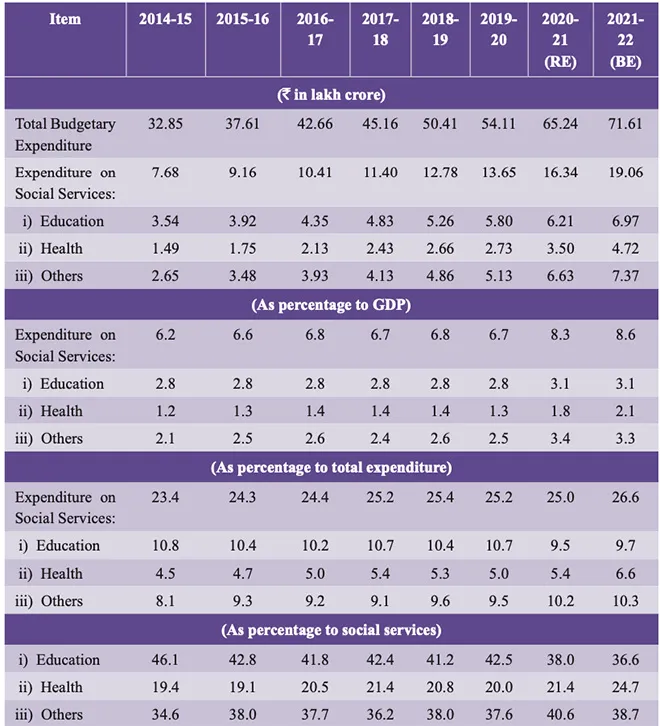 Source: https://www.indiabudget.gov.in/economicsurvey/
Source: https://www.indiabudget.gov.in/economicsurvey/
However, this failure to pump in required resources for augmenting health infrastructure does not necessarily mean that the health sector will not have the required funds to fight the pandemic. The experience from the previous two budgets (Graph 3) shows us that Budget estimates are not a great predictor of actual health spending for the year. In both pandemic years, budget estimates for the health sector got substantially revised upwards later in the year. Given that the political leadership has committed that money will not be a constraint to fight the pandemic, special allocations halfway through the year may well happen, if needed.
Graph 3: Budgetary Allocations for Health and the Revised Estimates during the pandemic
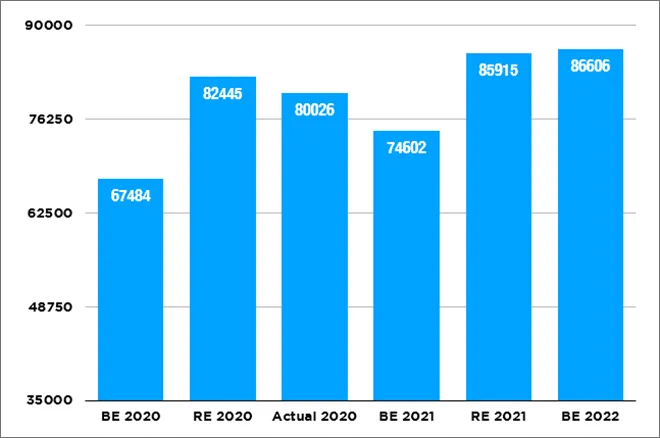 Source: https://www.indiabudget.gov.in/index.php
Source: https://www.indiabudget.gov.in/index.php
When one looks at the budget documents beyond the Ministry of Health and Family Welfare closely, there are more forward-looking initiatives within the broader health sector, similar to ABDM and NTMHP, which will strengthen the Indian health system. For example, Production Linked Incentive Schemes for promoting bulk drug manufacturing in India, as well as promotion of medical device parks have seen substantial allocations in this year’s budget. Also, autonomous bodies within the health sector, like the All India Institute of Medical Sciences, New Delhi; Post Graduate Institute of Medical Education and Research, Chandigarh; and the Jawaharlal Institute of Post Graduate Medical Education and Research, Puducherry have seen their overall allocation go up substantially over the last two years: From INR 7,565 crores in 2020 to INR 10,022 crores this year.
Overall, despite obvious limitations in enhancing infrastructure creation within the government healthcare delivery system, this budget is testimony to the fact that slowly and steadily, India is working on converting the Social Determinants of Health (SDH) framework into practice, with flagship interventions in key areas such as nutrition, drinking water, indoor air pollution, sanitation, road access and gender. The health externalities from these interventions can be amplified and almost magical improvements in the average Indian citizen’s health status can be achieved if there are focused efforts to ease the infrastructure and human resource bottlenecks within the sector.
The views expressed above belong to the author(s). ORF research and analyses now available on Telegram! Click here to access our curated content — blogs, longforms and interviews.

Oommen C. Kurian is Senior Fellow and Head of Health Initiative at ORF. He studies Indias health sector reforms within the broad context of the ...
Read More +